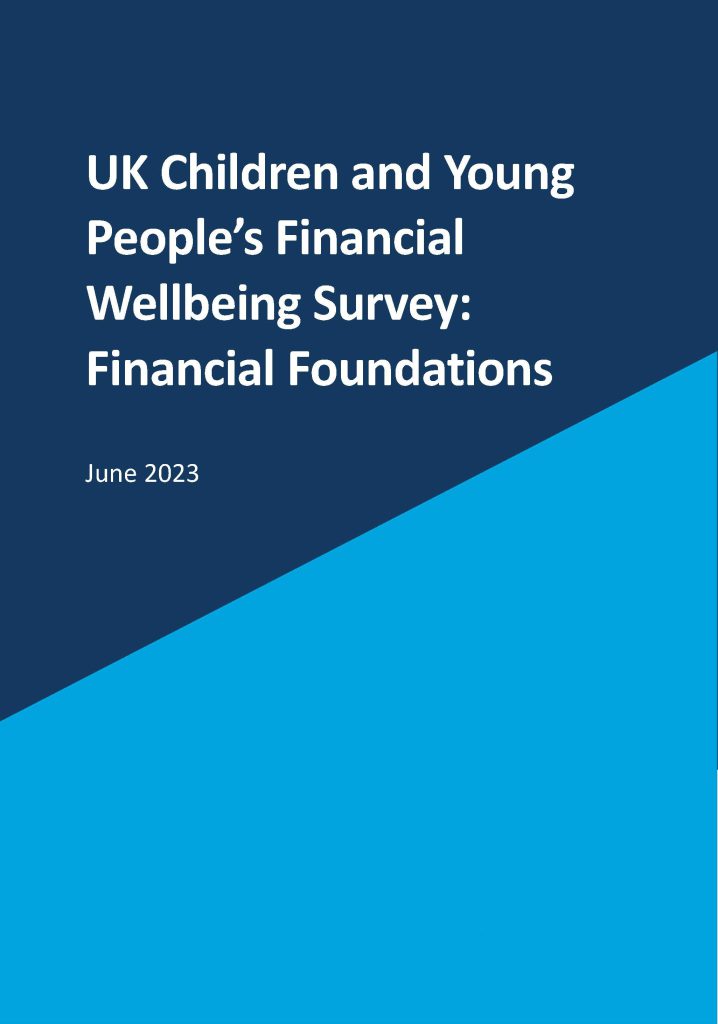UK Children and Young People’s Financial Wellbeing Survey: Financial Foundations
Previous research has shown that financial wellbeing, by the time of reaching financial independence, is in large part a consequence of what is seen, learned, and experienced during childhood and adolescence. The Children and Young People’s Financial Wellbeing Survey 2022 is a major source of insight regarding children and young people’s financial wellbeing as it currently stands.
Our vision at the Money and Pensions Service (MaPS) is ‘everyone making the most of their money and pensions’. In 2020, MaPS launched the UK Strategy for Financial Wellbeing 2020 – 2030, which is a ten-year framework to help achieve its vision. The Financial Foundations Agenda for Change, one of the five included in the UK Strategy, sets a National Goal of two million more children and young people aged five to 17 receiving a meaningful financial education by 2030.
What is the Children and Young People’s Financial Wellbeing Survey?
The Children and Young People’s Financial Wellbeing Survey is a nationally representative survey of children and young people aged seven to 17 (and their parents/carers aged 18+) living in the UK. The findings from the survey play a major role in producing robust measures of children and young people’s financial wellbeing and capability across the UK.
This triennial research measures the progress against the national goal as the sector works towards the goal. The results of last study of this kind, the UK Children and Young People’s Survey 2019, were published in January 2020.
The 2022 wave
This report focuses on the initial analysis of the progress made towards our National Goal from the 2022 wave of this survey.
The 2022 wave was conducted by Critical Research amongst 4,740 children and young people using a mixed methodology approach. The data collection period occurred between 18th August 2022 and 6th November 2022.
Weighting has been employed to ensure the overall reported population is representative of all young people aged seven to 17 in the UK. The nations with devolved governments (Northern Ireland, Scotland and Wales) were over-sampled to allow robust, separate analysis. The full technical report is available here.
How we define a meaningful financial education
The measure of a “meaningful financial education” is based on the percentage of children and young people who say they ‘recall receiving financial education at school that they considered useful’ and/or ‘received regular money from parents or from work and their parents set rules about money and give them responsibility for some spending decisions.’ Those who say yes to either or both are considered to have received a meaningful financial education.
What questions are included in the survey?
The survey is designed to further develop our research into the indicators, drivers and inhibitors of financial wellbeing including asking children about:
- How they get and spend their money
- Their attitudes to spending, saving and debt
- Their confidence and understanding about money
- If they recall receiving financial education, what they learnt and who they turn to for help and advice
We asked parents about:
- Their own attitudes and behaviours with money
- Their attitudes and approaches towards parenting relevant to money
- Their views on their child’s skills, abilities, attitudes, and behaviours with money
In addition to these questions, new questions were added to this year’s wave about children’s use of cash, and the shift towards digital payments, as well as questions relating to the impact of the Covid-19 pandemic on their school learning.
Key findings
- Compared to three years ago, the same proportion of children and young people have received a meaningful financial education as defined by the goal (47% in 2022 versus 48% in 2019). Progress is similar between the waves across the UK nations and age groups compared to 2019.
- The overall measure is driven by a third (33%) of children recalling learning about money in school and finding it useful, and nearly a quarter (24%) having received key elements of financial education at home. Only 10% report having both, suggesting that children and young people tend to receive meaningful financial education either at home or at school, not as a joined-up financial education. The data indicates that the cohort who receive it from both sources demonstrate higher levels of good day-to-day money management, suggesting a joined-up financial education is optimal.
- The findings (Section 5) indicate that children who have received a meaningful financial education are more likely to:
- Feel more confident about managing their money
- Disagree with the statement ‘I feel anxious when thinking about my money’
- Save money more regularly
- To have a bank account that they use
- To have positive attitudes towards money
- To talk about money
- To demonstrate positive day-to-day money management skills, such as shopping around to compare prices and planning ahead for how they will buy the things they need.
- Furthermore the cohort who receive it from both sources demonstrate higher levels of good day-to-day money management, suggesting a joined-up financial education is optimal. those who have received it at both home and school demonstrate the highest levels of good day-to-day money management, the highest level of confidence about managing money as well as highest proportions actively saving money at least monthly, supporting a joined up financial education is optimal.
- In terms of the home element of the goal, most children have responsibility about how they spend their money (91%), and over seven in ten receive regular money either through pocket money or work. However, only a third of parents/carers set rules about how their children spend their money.
- Just over half of parents/carers claim to feel confident talking to their children about money so supporting these parents to help their children is important.
- Some children are less likely than average to receive a meaningful financial education including young children (seven to 11 year olds), children living in social housing, rural areas and in lower income households and children whose parents/carers have mental health conditions.
These insights should strengthen the resolve of the financial education sector to ensure that, by 2030, we see a significant increase in the number of children and young people receiving this vital learning.
Further reporting and more detailed analysis on the findings from the 2022 wave of the survey will be published over the coming months.

